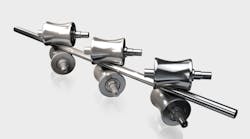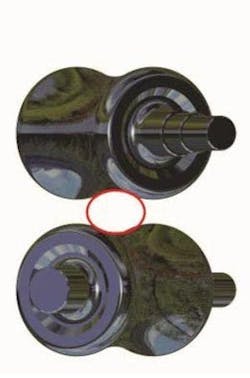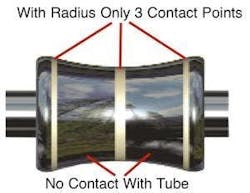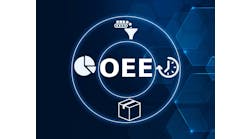Q: I need help calculating bending moments, so I can correctly-configure a 10-roll straightener to straighten tubes. The roll straightener consists of five rolls on the top and five rolls on the bottom. The rolls are serially positioned with respect to the top and bottom, and they’re offset from each other. We impart bending by positioning the three bottom inboard rolls. The rest of the straightening process is imparted by offsetting the rolls, though typical roll angles range from 30° to 37° with respect to the horizontal plane. The two outboard bottom rolls only have skew angle adjustment; otherwise, their heights remain constant and form a base pass line.
Nick Baranyk / [email protected]
A1: I like your question because it illustrates the wide applicability of process control principles. I might add these principles also apply to non-industrial processes, such as artificial intelligence (AI) evolution or climate control.
Rotary machines were developed because most tubes and pipes are neither straight nor round when produced. These machines are called rotary because they grip and rotate the pipe as it passes through them, while it’s subjected to pressure- and bending-straightening forces. In less exacting applications, there are three pairs of vertically opposed and individually driven rollers (Figure 1), while the more precise 10-roll machines have five pairs.
Ovalized sections of pipe require less force to collapse, and ovalization may also affect the integrity of the pipe coating as excessive deformation may result in damage. Pipeline ovality can occur if the pipe is incorrectly supported. Areas of soil transition, such as tie-in welds or road crossings, where the trench is in over-excavated regions, are also frequently concerning. The difference in compaction can cause a great amount of stress at the points of soil transitions. To prevent this, PipePillos pipeline supports can be placed in the trench prior to pipe placement or loosely tied to a pipe prior to lowering it in.
The straightening machines utilize both bend (or offset) straightening and pressure straightening. The profiles of the roll in the straightening machine are hyperbolic and only touch the pipe at three points (Figure 2). The number of bending moments produced is a function of the number of rolls (one with six rolls, two with 10). It’s difficult to set the required bending moments manually, and it requires a lot of experience. This is where process control enters the picture. Today, computerized systems are available, which guarantee that the resulting ovaility doesn’t vary as a function of operator actions.
Heavy-duty pipe straighteners are available to straighten up to 16-inch diameter pipes, having up to 38 mm wall thicknesses. The drive system for such large machines is about 400 hp.
Béla Lipták / [email protected]
A2: Achieving straight tubes is a function of regulatory control with the obvious target of getting zero curvatures. Your problem may require a complex, multivariable regulatory control solution, which may or may not be easily available. If the regulatory control you have is insufficient, it can be complemented with intelligent supervisory control that learns from operating data. For your needs, it could be configured to make adjustment decisions to achieve your objectives (feed-forward), assuming everything of interest is readily measured.
Carlos W. Moreno, Ph.D., CEO and founder, Ultramax Corp. / [email protected]
A3: Every control loop requires a sensor and an actuator, as well as a controller. So, how do you sense a pipe that is untrue? How do you adjust the rolls now? Manually?
Do the three adjustable rolls require three control loops, or can it be done with a single sensor and calculated roll positions?
Why do you need to know about bending moments when a controller's job is to reduce the error to zero? Or, is that how you calculate roll positions?
I've got a picture of the basics of the machine, but no clue as to the scale. Are you straightening house water pipes or cross-country pipeline pipes? Is the pipe from a coil or is it nearly straight? How big are the rolls? How fast does the pipe go through them?
The PTC Alliance website answers some of these questions, but not why you'd need to straighten the pipe, unless welding distorts it
If I understand you, this is not a problem that feedback control can solve. You seem to need the equation for how much to bend the tube to get the deformation required to straighten it. As you said, that depends heavily on the properties (and temperature) of the material. I'd have thought that various scientists and engineers would have published enough data, but perhaps it’s completely proprietary. Is your empirical data not adequate?
Does the amount of bending vary during a run? The machine as described can only straighten in one direction. Does it require multiple passes? Does the pipe somehow rotate going through?
Having a skew adjustment implies that the rolls are flat, not grooved. That means the machine is for a wide range of diameters, adding further depth to the knowledge required.
Bill Hawkins, Rosemount Controls (retired) / [email protected]








